Comparing and Contrasting the Herman Miller Aeron Chair and the Gokhale Pain-Free™ Chair
I frequently get questions about what makes a good office chair. Of course, some office chairs are primarily fashioned for style and aesthetic appeal. In general, I would say these may be easy on the eye, but, over time, hard on the body!
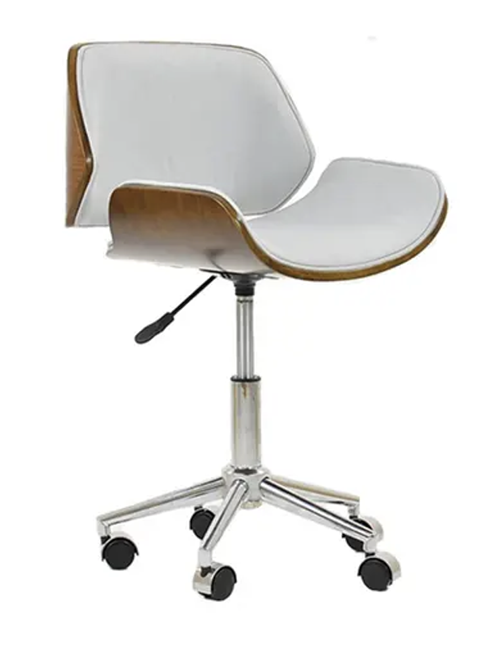
This office chair sparkles with 1960s retro-chic. However, its markedly concave seat will internally rotate your legs, encouraging malalignment in the hips and knees, and flat feet. Its straight backrest leaves no space for your behind, encouraging you to sit on your tail and tuck your pelvis. lakeland-furniture.co.uk
Ergonomic chairs
People often ask my opinion on how various ergonomic chairs on the market might help them. This makes sense given the rising prevalence of back pain¹. “Ergonomic” means that something is designed primarily for the health, comfort, and protection of users, and among the specific chairs people ask me about, the Herman Miller Aeron Chair tops the list. To answer efficiently, I like to compare and contrast it with the chair I designed, the Gokhale Method Pain-Free™ chair, as this embodies the posture principles confirmed by my research and experience.
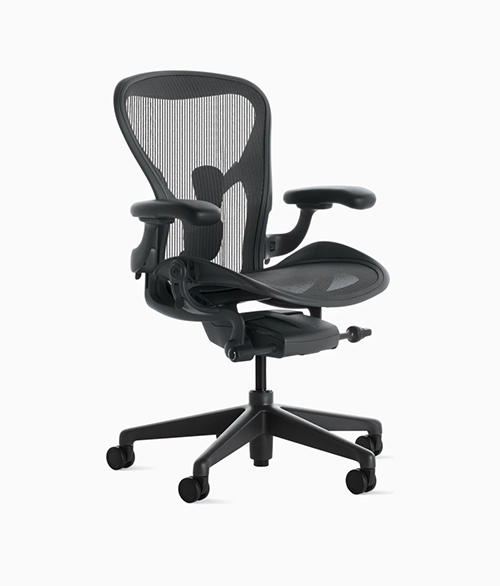
The Herman Miller Aeron Chair. hermanmiller.com

The Gokhale Method Pain-Free chair.
Even though they are both designed to be “ergonomic,” they are clearly very different. The Gokhale Method Pain-Free chair reflects the paradigm shift that underlies the Gokhale Method® philosophy. This makes the chair quite different from every other office chair on the market.
How chairs shape your spine
The Aeron chair has been designed following the conventional wisdom of the S-shaped spine, the “S” being formed by alternating lumbar, thoracic, and cervical curves. Over the last 100 years or so, this shape has become the received knowledge learned by physical therapists, medics, and designers, resulting in chairs whose contours support a significant curve in the lumbar area, and accommodate a thoracic curve in the upper back. From a Gokhale Method perspective this excessive curvature is the primary cause of disc bulges and herniations, nerve impingements, muscular spasms, and the degenerative conditions that cause back pain.

The Aeron chair is based on the concept of significant lumbar and thoracic curvature being desirable. hermanmiller.com
The Gokhale Method advocates a J-shaped spine, which is the shape we see in infants and young children, in historical artifacts and photographs, and which still persists in non-industrial societies across the world. The J-spine is especially relevant when sitting upright, where, due to an anteverted pelvis, the behind is behind and the vertebrae of the spine can stack more vertically. We call this stacksitting.
No tensing the back muscles to get upright, no collapsing into a slump—and no alternating between these two problematic positions, which is a common strategy to try and relieve the discomfort they cause. Just comfortable, healthy sitting. You can read more about spine shape here.
Sitting upright at your desk
Both the Herman Miller Aeron Chair and the Gokhale Method Pain-Free chair have a waterfall front (where the seat pan front angles downward), which is ideal for upright sitting. If you know how to arrange your legs and trunk well, this will facilitate pelvic anteversion and all the good things for your spine and general health that come with it. Pelvic anteversion is central to the Gokhale Method and is taught in our in-person Foundations Course, Pop-up courses, or online Elements Course.
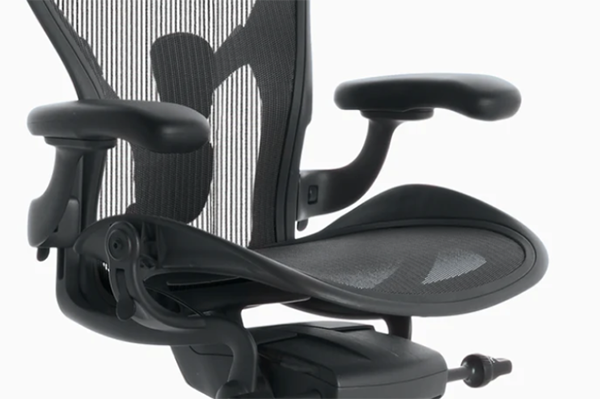
The seat pan of the Aeron chair features a waterfall front in a mesh fabric. Some users may find the adjustment lever under the seat is too close for easy operation when the seat is tilted forward for stacksitting. hermanmiller.com
I designed the seat pan of my chair using a combination of materials that give optimal support for sitting. The sitz bones need to experience a firm foundation for the pelvis and spine above, but they also need to be padded for comfort. In my experience this combination cannot be equalled or improved on by a single material or mesh fabric.
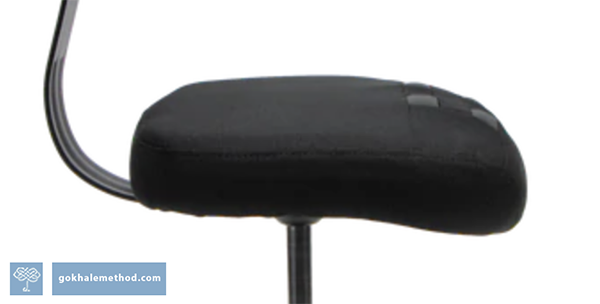
The seat pan of the Gokhale chair combines materials for optimal support and comfort.
Note that the metal backrest support is curved to accommodate the behind behind, another feature that helps in anteversion of the pelvis.
To further aid stacksitting the Gokhale Method Pain-Free chair seat pan also has four soft, textured, rubbery nubs sewn into its front edge. These provide grip which help keep your pelvic position, and prevent any slipping off the chair.
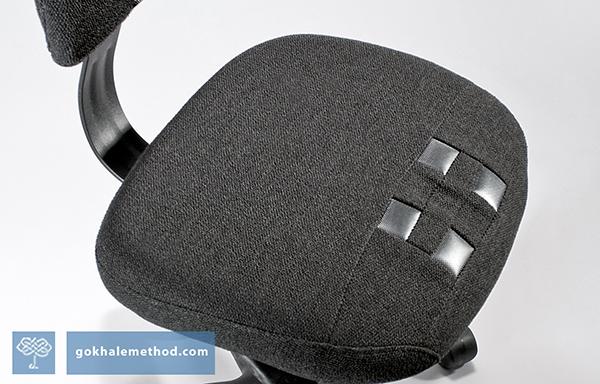
The Gokhale chair seat pan features four nubs which help you to stacksit for upright working at your desk.
Our seat pan is also slightly convex to facilitate external rotation of the legs and feet—that is, it encourages them to gently turn outward. This brings healthy alignment of the hip, knee, and ankle joints, and also the foot arches. A mesh fabric, pulled taut, cannot support external rotation in this way.
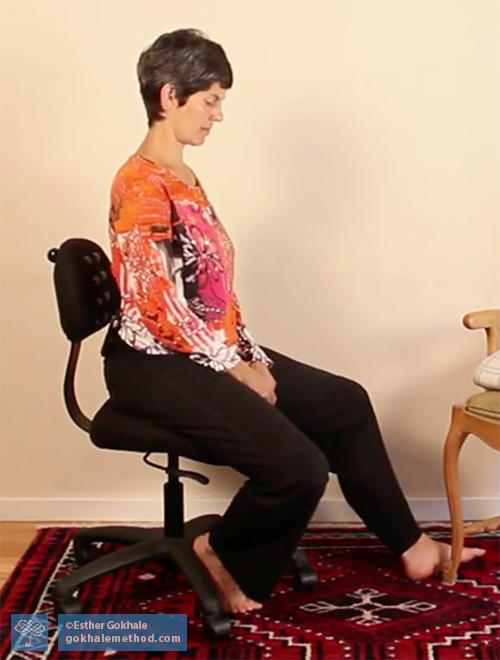
Stacksitting with healthy external rotation of the legs.
Armrests
Many office chairs come with armrests. It is healthier for the shoulders, which are very mobile joints, not to be continually fixed in position by armrests, however adjustable. Far better to learn to shoulder roll, which encourages range of motion and optimal arrangement in the joint. Shoulder rolls also help adjacent problem areas such as the trapezius muscle, neck, and upper back, and improve circulation to the area. A well-connected shoulder can support the weight of the arm effortlessly as you do your tasks.
Arm rests also create the significant problem of not being able to come close in to the keyboard, thus encouraging rounding of the shoulders. The absence of arm rests allows an almost cockpit like feeling of being surrounded by the desk and keyboard with no temptation to migrate the shoulders forward.
Backrests—traction trumps lumbar support
The Y-shaped feature at the back of the recent models of the Aeron chair has a support for the base of the spine which can be used to support the sacrum in mild anteversion. It also has a lumbar support which is less aggressively curved than that of earlier models. While these are considerable improvements, the mesh back of the Aeron chair is still not able to provide therapeutic length to the spine through traction, as the Gokhale chair does, or space for posterior shoulder placement. Nor does the backrest easily accommodate our trusty Stretchsit® Cushion.

A contemporary Aeron chair features support for the base of the spine (sacrum) and lumbar area. hermanmiller.com
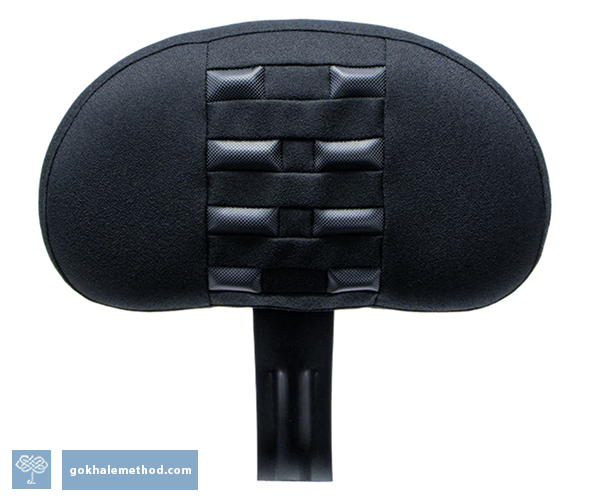
The Gokhale chair backrest provides therapeutic length to the lumbar spine with soft, built-in nubs for traction.
Beyond supporting a healthy J-shape in your spine, ideally a backrest would also help tease out any tension in the lumbar area. The Stretchsit Cushion success in improving back shape and reducing back tension has inspired the same successful features in our Pain-Free chair. With a little know-how, these soft textured nubs in the backrest can give you hours of therapeutic traction at your desk, reducing pressure on your spinal discs and nerves, and improving circulation in the surrounding tissues. We call this stretchsitting.
Are adjustable chairs better?
As consumers we have become increasingly familiar with hi-tech products that we can adjust and customize to meet our individual needs and preferences, and the Aeron chair reflects this throughout its design.
The Gokhale Method Pain-Free chair requires just one adjustment, and that is the gas lift height adjuster. This is key to the use of the chair, which is designed to be raised for stacksitting so the thighs and pelvis can angle downward, and lowered a little for stretchsitting against the backrest so that the feet can still meet the floor well. The lifting mechanism comes in three different heights, and there is also our Petite Gokhale Method Pain-Free™ Chair, ideal for both smaller people and smaller spaces.
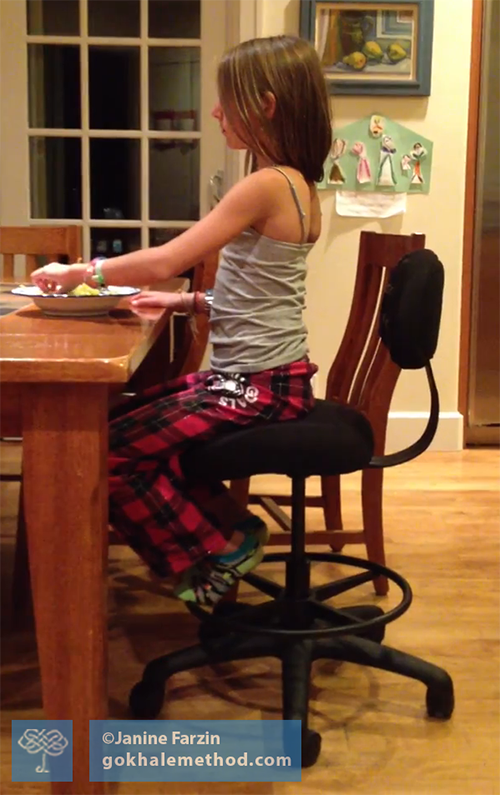
The Petite Gokhale Method Pain-Free chair gives a range of working heights, and a foot ring.
Foot rings
One additional feature on our Petite Gokhale chair is a foot ring, which gives more options for foot and leg placement, and prevents legs from dangling and pulling the pelvis into a tuck. It also avoids the constriction to circulation which may occur if the thighs hang over a seat edge.
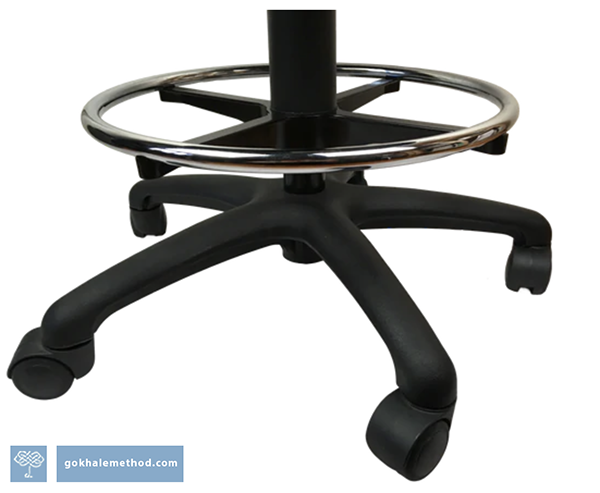
A foot ring helps take care of the lower body—an area often overlooked in conventional office chairs.
From a Gokhale Method perspective, adjustments for spinal curves or arm rests are simply not required once the basics of healthy posture are understood. Better to address these fundamentals before going all out on the bells and whistles. This means there’s less to go wrong—with your chair, and your body!
Sitting well is a partnership
Almost every employer who wants to demonstrate care for their executives finds themselves purchasing a Herman Miller chair. Yet within the budget of an Aeron chair they can buy a Gokhale chair and treat their employee to a one day Pop-up Course or six-lesson Group Foundations Course in the Gokhale Method where they will learn postural skills that last a lifetime.
Healthy sitting is a partnership. It takes a good chair on the one hand, and good posture on the other. With the Gokhale Method Pain-Free™ chair and the Gokhale Method you have the perfect combination.
References:
¹Janet K. Freburger et al., “The Rising Prevalence of Chronic Low Back Pain,” Archives of Internal Medicine 169, no. 3 (Feb. 2009), 251–58, doi: 10.1001/archinternmed.2008.543
If you would like to find out more about how the Gokhale Method can help support you, sign up to join one of our upcoming FREE Online Workshops…

Comments
Several months ago I asked
Several months ago I asked Esther if she has ever tried the womb chair. It is a chair for the living room or family room. I use her chair at my desk and love it. I use the womb chair in my family room and am would be interested to know her opinion if she ever sits in one. It is one thing to see it and quite another to sit in it!
I have an X-Chair and have
I have an X-Chair and have not been very happy with it. I'd be interested in any comments re: best way to adjust it.
Add New Comment
Login to add commment
Login